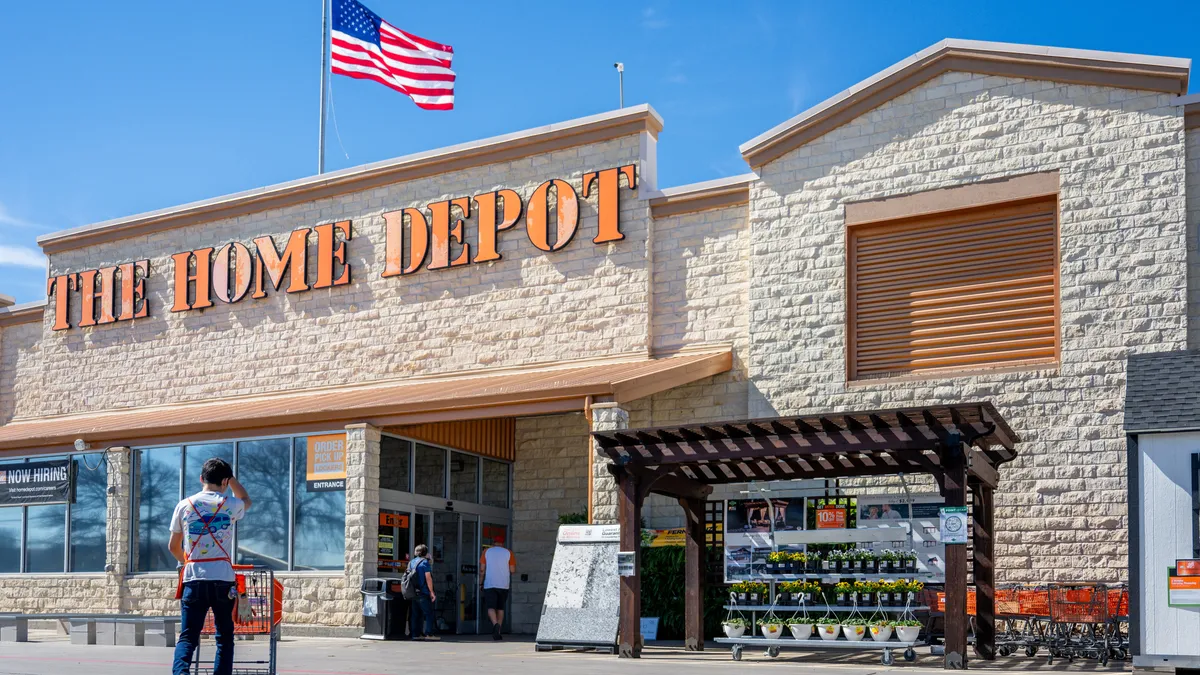In a 10-year span, Nike's revenue more than doubled. On its own, that metric may not sound especially unique. However, the athletics brand was already making $20.1 billion annually in 2011. That means it grew revenues by more than $20 billion over those 10 years, and in fact, revenues surged an extra $4 billion or so on top of that, to $44.5 billion.
"Nike's position as an apparel company is unique. There are very few brands of its size," Matt Powell, senior industry adviser for sports with the NPD Group, said via email.
To be sure, Nike is a giant within its own sporting goods space, eclipsing its closest competitor Adidas by over $20 billion, but it also makes quite a bit compared to the retail space at large. And there's no sign of stopping ahead: The retailer is projecting net sales will hit $50 billion by its next annual report.
"Achieving high revenue above $50 billion is not all that unusual in retail," GlobalData Managing Director Neil Saunders said via email, citing companies like Amazon and Walgreens. "However, all those players sell a lot of different things and brands rather than mostly focusing on their own brand — like Nike does. So in that regard, Nike is quite unique. Nike is the leading global brand in apparel and footwear by a large margin, followed by Adidas and then Zara and then H&M. However, there is another brand whose revenue eclipses Nike and which is arguably more ubiquitous and well known: Apple."
Revenue and store count at a selection of top retailers
Apple, in its first quarter alone this year, made over $111 billion, well above Nike's annual figures. Still, the athletics brand rakes in an enormous amount of sales, thanks to years of building its brand and stealing market share. In the '80s, Adidas and Reebok were neck-and-neck with Nike, and Reebok even made more than Nike for a time, but the company has since pulled away significantly, capitalizing on Michael Jordan stardom and its dominance in the U.S. to stay ahead of rivals.
There are several contributors to Nike's success. Saunders, for one, pointed to Nike's distribution capabilities, global reach and innovation as key to its growth over the years. Others have highlighted the brand's use of data and focus on a connected customer experience or the company's relentless pursuit of excellence.
"However, at the heart of Nike's success is the power of its brand, which has been created and maintained through understanding customers, having an extremely clear vision and communicating this in a very compelling and engaging way through marketing," Saunders said. "Nike is one of the world's power brands and its swoosh is recognized by people on every continent."
Below, we break down just how big Nike is by comparing its annual revenue to that of other major retailers in the U.S.
How Nike compares to other major athletics brands
When compared to the other major names in the athletics space, Nike seems far and away the winner. However, it's important to take into consideration the relative age of some of those players. As Powell put it, "Nike is nearly 60 years old." Lululemon, on the other hand, was founded in 1998, while Under Armour was founded in 1996.
Nike makes about $40B more than Under Armour and Lululemon
"Lululemon is 23 years old and during its lifetime has gone from nothing to a $4.4 billion revenue business. In its first 23 years Nike went from nothing to a $1.2 billion revenue business in 1987 — the equivalent of $2.9 billion in today's money," Saunders said. "So, in some ways, you could actually argue that Luluelmon is growing faster than Nike did in its early days."
Under Armour and Lululemon are also more niche than Nike, experts said. Nike competes more broadly in the footwear space than the others, and Lululemon is centered more squarely around yoga and wellness. Nike possesses a far greater global distribution than the two younger brands, which are more focused in North America. But perhaps the biggest differentiator is Nike's hold on the U.S. market, which also helps explain its dominance over Adidas, which was founded long before Nike, in 1949.
"The differential between Nike and Adidas is the U.S.," Powell said. Outside the U.S. the brands compete more equitably, but Nike is four times the size of Adidas in the U.S., according to Powell.
"Adidas has failed to make compelling product for the U.S. market. Sports is entertainment in the U.S. Nike dominates sport," Powell said.
On a less tangible front, Nike has strong brand resonance. The company has become well-known for powerful, and gutsy, marketing campaigns, and has largely managed to withstand challenges to its image over the years. Nike remains one of the top apparel brands for teens, even as others falter.
Nike has "spent a lot on marketing and made it a priority to sign top athletes and remain culturally relevant (sometimes making social statements), making the brand top of mind for consumers," Cristina Fernández, a senior equity analyst at Telsey Advisory Group, said via email. "Lastly, Nike has been a more consistent operator whereas other brands have had execution missteps over the years."
How Nike lines up against other retail darlings
Retail always has its favorites, which have impressed for one reason or another, and therefore remain closely watched by competitors and often praised by outsiders. Nike is certainly a favorite in its own space, but how much does the retailer make compared to other retail favorites?
With its global reach, Nike outpaces some US-focused retailers
Ulta, which many have admired over the years, especially as former CEO Mary Dillon built up the company to what it is today, makes what amounts to a fraction of Nike's annual revenue. At $6.2 billion, though, it is considered a leader in the beauty space. As Saunders points out, Ulta serves mostly women, while Nike is both a men's and women's brand.
Likewise, many of the companies highlighted above don't have the global scale that Nike does, as they are focused on the U.S. market. That limits revenues and explains some of the discrepancies.
"Dollar General is mostly U.S., so it actually does very well to be just $10 billion behind Nike, which sells all over the world," Saunders said. "Dollar General's whole model is based on volume, which it secures by selling consumables, which people buy regularly. The price of each item is low, but it sells a phenomenal number of products each year. When you think about it, the average household spends far more on food and household goods than on sneakers and sports gear, so it's not surprising that a food player can generate strong sales results."
For Home Depot, which makes about three times as much as Nike, the company operates in a much larger market and is the "clear market leader," Saunders said. Spending from professional tradespeople also helps bolster its sales further, as these are "massive industries, which spend a lot on home improvement products." In terms of market size, Fernández highlighted that the U.S. home improvement market is approximately $700 billion, compared to the $300 billion global athletic apparel and footwear market.
"Relative to the U.S. retailers, a big difference is Nike's global scale, with 40% of revenues from North America and the rest from overseas," Fernández said, noting it sells through multiple channels as well. "Nike also has a high market share (39% of global athletic footwear and 13% of global athletic apparel) whereas many others have a small share of their respective markets. Nike is also a company rooted on product innovation, which gives it control and pricing power with customers and retailers."
How Nike compares to department stores
The department stores outlined above fall into the same bucket as many of the retail darlings discussed: They are largely U.S.-based, and therefore operate on a smaller scale than Nike. That alone accounts for a large part of Nike's revenue advantage, which amounts to nearly three times what Nordstrom, Macy's and Kohl's each make per year. Even if the revenues from those three department stores were combined, Nike still edges them out.
Nike's revenue nearly triples that of US-based department stores
But department stores also face a more existential crisis as they try to find a place in a world that has in many ways moved beyond them, with players like Target filling the gap.
"Department stores are failing and have been failing for years, so it's hardly surprising that they are lagging well behind Nike," Saunders said. "Also the brands are tarnished and old. Nike still feels new and innovative, brands like Macy's and Dillard's just feel tired."
While the model as a whole may be failing, even Nordstrom, which has been praised by many as one of the few department stores getting things right, falls well short of Nike's revenue mark. Nordstrom's annual revenues amount to less than a quarter of Nike's.
How some of the biggest retailers line up against Nike
Although Nike's global scale helps it beat out many major retailers when it comes to revenue, looking at some of the biggest retailers in the U.S. helps put the company's sales into perspective. Even excluding Walmart, whose scale is hard to rival, Target and Costco make well over double and triple, respectively, Nike's revenue.
Retail's biggest players still far out-strip Nike
"The big-box retailers … carry a much broader assortment of products than Nike does, hence their greater sales," Powell said.
Walmart, Target and Costco compete in categories like food, consumables, electronics and toys, in addition to apparel, Fernández said. Food in the U.S. alone is a $1 trillion industry, according to Fernández, and "many of these categories are staples which consumers buy on a weekly/ monthly basis."
Saunders agrees and believes food is the major driver of high revenues for Walmart and Costco. "Both players are extremely effective operators who have excellent distribution capability and a strong reputation for value — which is very important to food shoppers," Saunders said.
While Target's revenue is nowhere close to Walmart's and Costco's, it is "impressive" given the company is a U.S.-only business, Saunders said. And even as a U.S.-focused company, Target rakes in significantly more than the sportswear giant.
It's hard to compare many of these retailers apples to apples, since they vary in global scale and product assortment, but doing so can help illuminate just how much some of retail's biggest players make — and why.






















